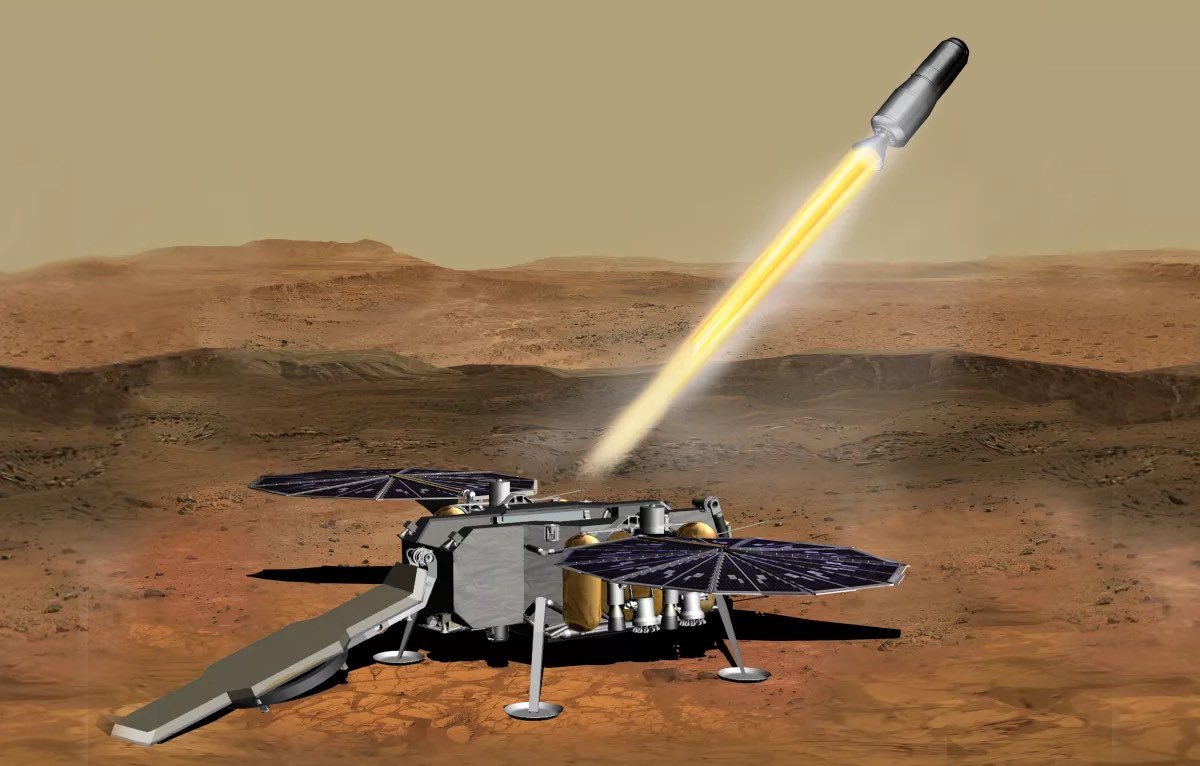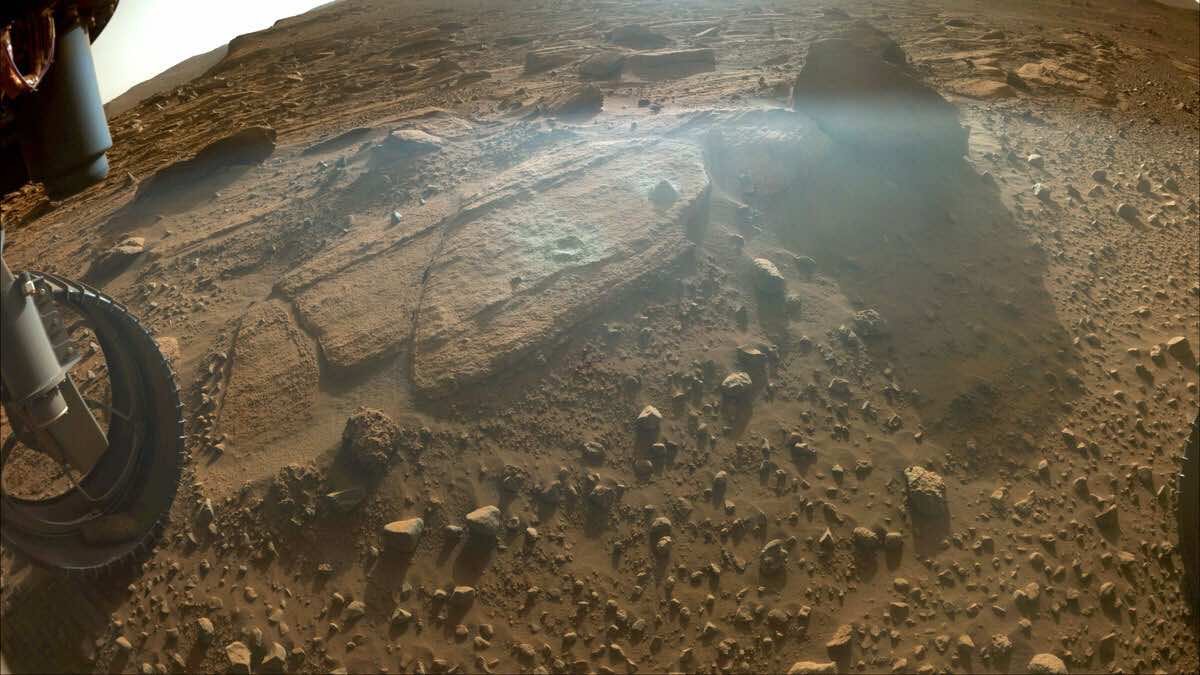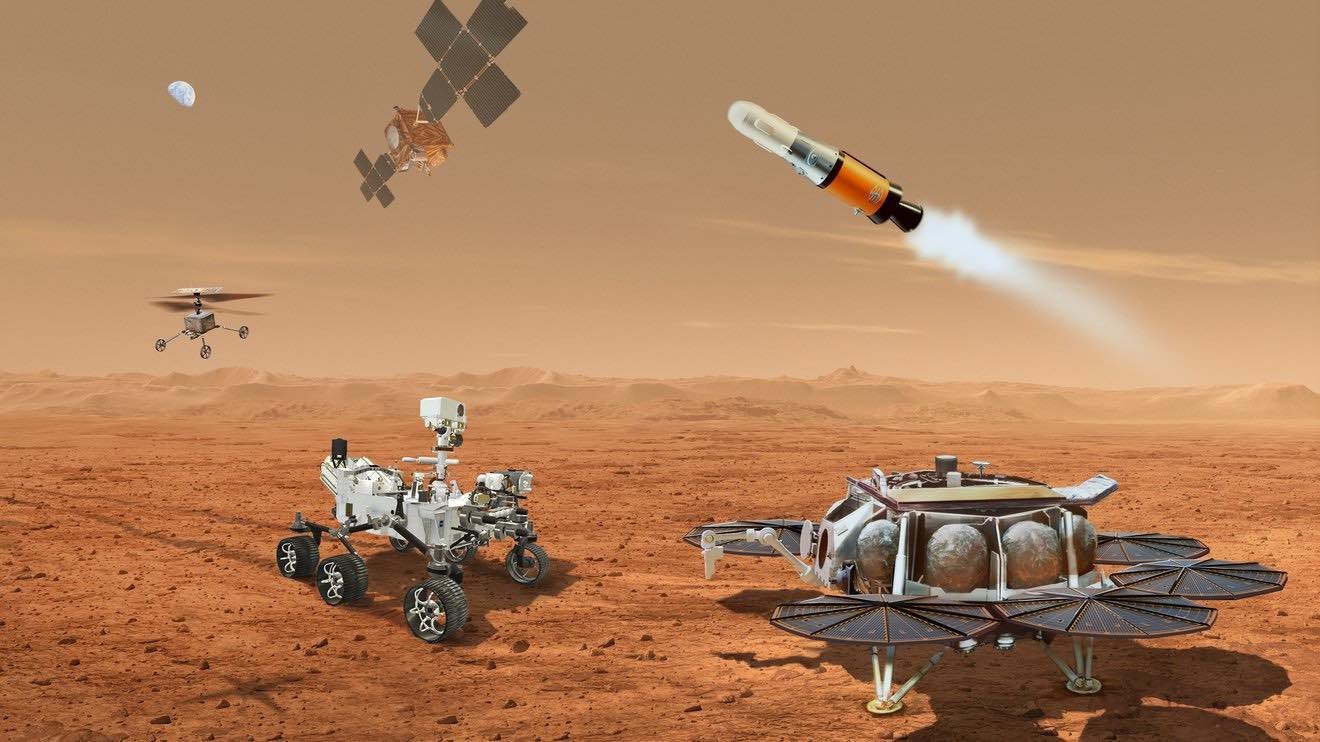

Welcome to this week’s installment of The Intelligence Brief… recent tests being carried out by NASA are paving the way for the historic first rocket launch from another planet. In our analysis this week, we’ll be looking at 1) how NASA plans to launch a rocket from the surface of Mars, 2) an update on the ambitious Mars Sample Return program that will facilitate the launch, 3) the program’s one-of-a-kind ascent vehicle, and 4) how current tests with a pair of rockets at a Northrup Grumman facility are already showcasing the promise of NASA’s sample return mission.
Quote of the Week
“I’m never going to go to Mars, but I’ve helped inspire, thank goodness, the people who built the rockets and sent our photographic equipment off to Mars.”
– Ray Bradbury
Latest News: This week in reporting from The Debrief, new readings and an evaluation of previous readings have confirmed potential biosignature phosphine in the clouds of Venus. Also, Tim McMillan and I look at how the Pentagon’s chief scientist involved in the investigation of unidentified anomalous phenomena (UAP) fired back at assertions made during a Congressional hearing last week that his Office was not being fully transparent with its findings. You can find links to all our latest stories at the end of this newsletter.
Podcasts: In podcasts from The Debrief, this week on The Debrief Weekly Report, MJ Banias and Stephanie Gerk discuss whether solar panels will be replaced by “rain panels” and take a deep dive into the congressional hearing on UFOs. Elsewhere, I continue the analysis over on The Micah Hanks Program, where I look at the recent hearing and the explosive statements the former military witnesses provided under oath to members of Congress about the U.S. federal government’s involvement with UAP. You can subscribe to all of The Debrief’s podcasts, including audio editions of Rebelliously Curious, by heading over to our Podcasts Page.
Video News: This week on Rebelliously Curious, Chrissy Newton sits down with Marcus Capone, a veteran Navy SEAL who returned home after 13 years of active combat duty to face his own battle with mental health and eventually turned to (PAT) Psychedelic-Assisted Therapy. Also, check out the latest episode of Ask Dr. Chance, where Chance answers his listener’s questions about artificial intelligence. Be sure to watch these videos and other great content from The Debrief on our official YouTube Channel.
And now, it’s time to take a look at NASA’s plans for what will become the first rocket launch to take flight from another planet.
Blastoff: The Martian Chronicles
Although once a reality only in science fiction by the likes of Ray Bradbury, the real-life launch of a rocket from the Red Planet is closer than ever to becoming a reality now, thanks to recent tests NASA conducted with a pair of solid motors that, in the coming years, will help them launch the first rocket into space from the surface of Mars.
The tests were conducted in support of the Mars Sample Return program, involving NASA’s Mars Ascent Vehicle (MAV) that will be used to carry samples collected from the surface of the Red Planet back to Earth for study and evaluation.


Utilizing two solid rocket motors that will serve as the first and second stage rockets for the launch, recent tests carried out at Northrop Grumman’s facility in Elkton, Maryland, were a smashing success, paving the way forward for what the American space agency hopes will represent far more than just the first rocket launch from one of Earth’s planetary neighbors: it will demonstrate the first human retrieval of samples from another planet in our solar system.
The Mars Sample Return Program
Now many years in the making, NASA’s ambitious Mars Sample Return program will bring samples collected on Mars back to Earth, allowing these scientifically curated specimens to undergo rigorous study that would not be possible even with the most capable instruments aboard the Perseverance rover.
In partnership with the European Space Agency (ESA), the program will retrieve the samples Perseverance has collected during its exploration of Jezero Crater over the last several years since its arrival at the end of July 2020.


“The samples currently being collected by NASA’s Perseverance Rover during its exploration of an ancient river delta have the potential to reveal the early evolution of Mars,” read a recent press release issued by NASA’s Jet Propulsion Lab (JPL) in Pasadena, California, “including the potential for ancient life.”
A One-of-a-Kind Ascent Vehicle
The Mars Ascent Vehicle, or MAV, plays a crucial role in the mission to bring the samples Perseverance has collected back to Earth.
The MAV spacecraft component of the mission has been managed out of Huntsville, Alabama at NASA’s famous Marshall Space Flight Center, where tests and analysis of all the spacecraft’s components have been rigorously undertaken in preparation for its launch in June 2028.
Once the spacecraft is sent on its way toward Mars, it will travel for a period of two years before landing an spending an additional year retrieving the samples collected by Perseverance. If all goes according to plan, at some point in the early 2030s, the MAV will blast off again, beginning the final stretch of its mission to bring a unique collection of promising scientific samples home from the Red Planet.
Once in orbit, the MAV will then eject a sample container from its location in orbit around Mars, which will rendezvous with the Earth Return Orbiter and retrieve the Martian samples for Earth delivery.
Ensuring a Successful Martian Rocket Launch
The two solid rocket motors recently tested at Northrup Grumman’s Maryland facility, the SRM1 and SRM2, will each perform slightly different missions.
SRM1 will carry the MAV away from Mars, while the SRM2 component will work to ensure that MAV’s second stage travels where it needs to in order to ensure the precious sample container it carries will find its way to the correct location in orbit, thereby allowing its discovery by the Earth Return Orbiter.


According to a JPL statement issued earlier this week, the successful tests of the SRM1 occurred in a vacuum temperature in extremely cold temperatures and featured specially designed apparatus designed by Northrup Grumman involving a trapped ball nozzle with a supersonic split line to help facilitate the extreme testing environment.
MAV Propulsion Manager Benjamin Davis said the recent test “demonstrates our nation has the capacity to develop a launch vehicle that can successfully be lightweight enough to get to Mars and robust enough to put a set of samples into orbit to bring back to Earth.”
“The hardware is telling us that our technology is ready to proceed with development,” Davis added.
That concludes this week’s installment of The Intelligence Brief. You can read past editions of The Intelligence Brief at our website, or if you found this installment online, don’t forget to subscribe and get future email editions from us here. Also, if you have a tip or other information you’d like to send along directly to me, you can email me at micah [@] thedebrief [dot] org, or Tweet at me @MicahHanks.


Here are the top stories we’re covering right now…
- The U.S. Air Force is Developing a Plasma ‘Freeze Ray’ to Keep Things Cool in Space
The U.S. Air Force is tapping into the seemingly magical properties of plasma to develop a freeze ray that can keep components cool in space.
- Groundbreaking Algorithm Successfully Identifies First ‘Potentially Hazardous Asteroid’
Discover how the HelioLinc3D algorithm spots ‘Potentially Hazardous Asteroids,’ enhancing Earth’s defense and safety from celestial threats
- U.S. Law of War Gets a Reboot as the Pentagon Updates Its Handbook on Law in Military Operations
The Department of Defense announced this week that it has issued an update to its official manual that governs the implementation of law in military operations.
- Another Robust Phosphine Signal From the Clouds of Venus Significantly Bolsters Case for Alien Life
New readings and an evaluation of previous readings have confirmed potential biosignature phosphine in the clouds of Venus.
- Director of Pentagon’s UAP Investigations Challenges Claims Made in Recent UAP Hearing
The Pentagon’s chief scientist involved in the investigation of unidentified anomalous phenomena (UAP) fired back at assertions made during a Congressional hearing this week that his Office was not being fully transparent with its findings.
- Navy SEAL Veteran Transforms Mental Health Care with Psychedelic-Assisted Therapy
Veteran Navy SEAL Marcus Capone discusses psychedelic-assisted therapies and their potential benefit for former U.S. armed service personnel.
- The Congressional Hearing on Unidentified Anomalous Phenomena
In this installment of The Micah Hanks Program, we provide an analysis of last week’s hearing and the explosive statements the former military witnesses provided under oath to members of Congress.
- Science Fiction to Science Fact: Miniature Robots Crawl Inside Human Body to Perform Laser Surgery
Miniature robots right out of science fiction ride magnetic waves deep inside a human body to perform ultra-precise laser surgery.
- U.S. General’s Claim of Divine Ethics in American Defense Technology Misfires
A U.S. Air Force General has recently argued that American AI is “more ethical” than that of its adversaries.
- UFOs Go To Washington This week on The Debrief Weekly Report…
On today’s episode, we discuss whether solar panels will be replaced by “rain panels,” a new idea for a form of archaeology for all the artifacts left in space by humans, and a deep dive into the congressional hearing on UFOs. You can listen to the episode on Apple Podcasts, Spotify, by riding some gravity waves, or simply download it wherever you get your podcasts. Please make sure to click ‘Subscribe’ and Rate and Review the podcast. Every Friday, join […]
- The Congressional Hearing on UAP: What We Learned From Yesterday’s Testimony
This week’s Intelligence Brief newsletter looks at the key takeaways from the latest in a recent series of Congressional hearings on unidentified anomalous phenomena (UAP).
- Crashes, Casualties, and Cover-Ups: Assessing the UAP Whistleblower Claims
This week, we take a balanced look at historical cases involving UAP crashes, deaths related to UAP incidents, and other details in the controversial claims made by UAP whistleblower David Grusch.
- Lockheed Martin to Build Experimental Nuclear Propulsion System for Joint DARPA and NASA Collaboration
DARPA and NASA have selected Lockheed Martin to help build a nuclear propulsion rocket capable of taking humans to Mars for future missions.
- Congressman Provides Account of Military UAP Image That He Says Matches No “Human Capability”
Florida Rep. Matt Gaetz says he was recently shown a UAP image by USAF personnel that he was “not able to attach to any human capability.”
- Whistleblowers Testify Under Oath Regarding “Craft of Non-Human Origin” and Military Encounters with UAP
Congress has received testimony from three former officials about UAP encounters and alleged U.S. retrievals of craft of non-human origin.